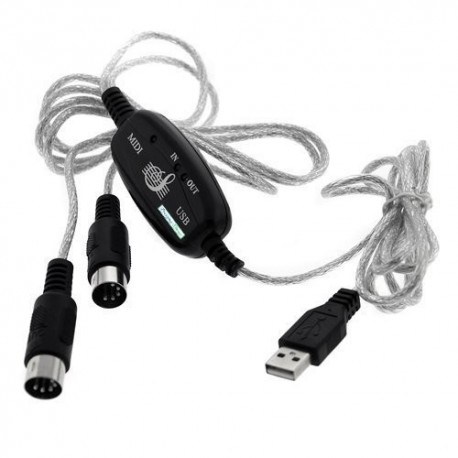Midi In Out Cables
Posted : admin On 07.10.2019After googling around for a bit, I came across a few basic schematics. This one was the schematic I was planning on following, but I had to deviate slightly. My local Fry's Electronics didn't carry a 6N138, but they had the NTE equivalent which I found was a NTE3093. I had resistors at home, but I found I was out of 220 ohm, so I went with 270 ohm, which appear to work just as well. I didn't care about sending MIDI signals out of my PC, so I left that part out of my design. I wanted all the parts to fit within a DB15 casing.
Now that all the parts are in a nice little ball, I put some heat shrink over them to protect and insulate them. Since it fits in the DB15 hood with no issue, I do what I do with most of my projects, fill them with hot glue. The glue keeps parts from shaking around, breaking or falling out. Plus, it gives the plug a satisfying weight. I inject the plug half with glue then smash down the top piece, cutting off the excess with a razor.
Mobile MIDI like never before. Like iRig MIDI before it, iRig MIDI 2 features three MIDI ports: IN, OUT and THRU. But this time around the ports are standard-sized and require no adaptor or special cable to use — in fact, you can use any standard MIDI cable you'd like. If you want to connect your controller keyboard and other MIDI gear to you iOS device, then check out the selection of iPad/iPhone MIDI interfaces at Sweetwater. These MIDI interfaces range from one to 10 MIDI ports, allowing you to connect up to 1,280 channels worth of MIDI connectivity at once. GREATLINK Midi to USB Cable Interface Converter - in Out Midi Cable Host Plug Controller Wire Cord for Keyboard Synthesizer Piano Instrument to Mac Computer PC Windows Laptop Music Studio (6 FT) by Great Link.
Midi Breakout Cables

Then tape around it tightly, and give it 15 minutes to cool down. I now have a nice MIDI in converter cable with all the parts self contained in the cable. It works much better than my M-Audio USB uno. Hooray for old technology.

Making a USB to MIDI controller would require much more circuitry. The reason this circuit is so simple is because most sound cards and motherboards which have a Joystick port already have MIDI IN and MIDI OUT on pins 15 and 12 respectively. Actually, I think you could probably wire the instrument directly to these pins, however putting the optocoupler and friends into the design protects both the MIDI device and the PC from destroying each other. More information about the Joystick/Game port pinout.